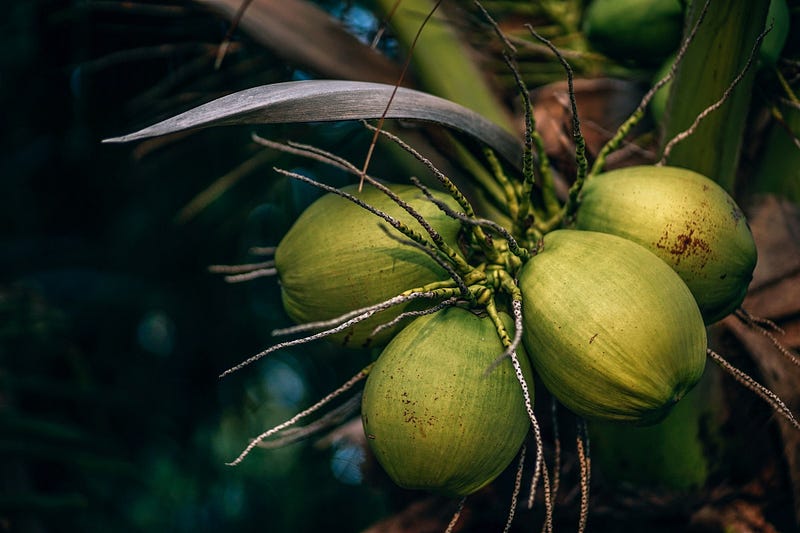Coconut Coir: The sustainable alternative?
Coconut coir has long since ceased to be an insider tip. The many advantages in horticulture and the low price are tempting arguments in its favor. Compared to conventional plant soil, it is cheaper and optimally supplies the roots with air, water and nutrients. A perfect overall package, right?
Let’s start small first: What is coconut coir?
Strictly speaking, coconut coir is not soil. It is compressed coconut fibers that are formed into compact bales. Thus, it consists of 100% biodegradable fibers that come directly from the shell of the unripe coconut. A closed-loop system that is unparalleled.
For your first own farm, the investment doesn't have to be big at all. Coco sticks & net baskets are cheap to buy!**
But these are not all the advantages that bring coconut coir. Since it is often sold in dried and compressed form, it is easy and convenient to transport. Lugging around 25 kg bags of soil is history. With coconut coir, it is enough to mix the dried bale with the appropriate amount of water at home and let it set. In this way, fresh coco coir is created after a short time. Since the fibers were sterilized before drying, the coir is free of pests or fungi.

Among all plants, the coconut or coconut palm is probably one of the best survivors. Thanks to its unique cell structure, which stores water and nutrients particularly well, the coconut has been able to settle and take root in the most barren places.
But is coconut coir really a sustainable alternative to conventional plant soil?
In direct comparison, conventional soil actually has no chance against coconut coir. It is heavy, cannot store nutrients as well, and has poorer water conductivity. This then also leads more quickly to root rot, a problem that occurs rather rarely with coconut coir. In addition, conventional potting soil often contains peat.
Peat is an organic sediment (deposit), which is particularly suitable for water and pH regulation of soil. So, an important component for many gardeners*. However, its decomposition is not particularly environmentally friendly: since peat can only form under aerobic (low-oxygen) conditions, it is almost exclusively produced in peatlands. The extraction of peat thus releases large amounts of CO² and destroys significant habitats for plants and animals.
It doesn't always take experts to try their hand at hydroponic farming. With this indoor greenhouse, you can get started right away.**
And yet, in the end, the coconut coir probably comes off worse. That’s because the tropical coconut palm doesn’t grow just around the corner from us. The cultivation of coconut palms is a real climate killer. Large parts of the rainforest are cleared for coconut plantations and ecosystems disappear irretrievably. But that’s not all, the local population also suffers greatly. They are often exploited and expropriated on site, and the big profit is taken by large corporations. But they only do this as long as we continue to demand it. As is so frequently the case, the problem is the high demand of the market. Due to the great demand for cheap vegetable oils and fats, such production conditions arise. Especially these plannable, cheap and stable monocultures (e.g., coconut plantations) make it easy for the industry to calculate well and to push prices down.

Still feel like building your own hydroponic farm? To get started, we recommend these lettuce plants.**
So it’s really worth checking the contents lists of products the next time you go shopping and avoiding products with palm oil/palm fat. It is also worth looking for the GEPA or Fairtrade seal when buying coconut coir, which is the only way to save some houseplants. This ensures that at least the working conditions are fair, and the environment is perhaps not quite so badly affected.
Those who want to stick with conventional plant soil, you can do it without further ado. Of course, the most suitable for this purpose is a home compost. This “produces” fresh soil from garden and organic waste. If you use purchased soil, make sure you buy soil with as little peat as possible.
**The links to sources of supply are affiliate links: If you buy through them, you actively support gustar.io, because we then receive a small part of the sales proceeds. Thank you very much! :-)
Sources:
Kokoserde — Für pflanzen und Moore. (n.d.). Retrieved February 19, 2021, from https://www.reportagen.de/reportagen/view/326/Kokoserde-Fuer-Pflanzen-und-Moore
6. Juli 2019von Melanie HagenauKategorien: Haushalt & Wohnen. (2020, July 08). Kokoserde: Wie sinnvoll ist Die exotische alternative für Erde? Retrieved February 19, 2021, from https://utopia.de/ratgeber/kokoserde-wie-sinnvoll-ist-die-exotische-alternative-fuer-erde/
Blumixx. (n.d.). Kokoserde — Die nachhaltige ALTERNATIVE. Retrieved February 19, 2021, from https://www.blumixx.de/magazin-praxis-tipps-kokoserde-die-nachhaltige-alternative
GEPA Kokoblock — Kokoserde als BLUMENERDE — ohne DÜNGER und Torf-frei “ ecoco wiki. (2021, February 12). Retrieved February 19, 2021, from https://www.ecoco.bio/wiki/gepa-kokoblock-kokoserde-blumenerde-ohne-duenger-und-torf-frei/
Katharina. (2019, July 19). Kokoserde Statt blumenerde: Diese Pflanzen Lieben kokos. Retrieved February 19, 2021, from https://www.plantopedia.de/kokoserde/




